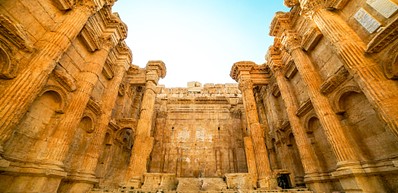
-
![Corniche Beirut]() Provided by: diak/Shutterstock.com
Provided by: diak/Shutterstock.com -
![Pigeon Rocks, Beirut, Lebanon]() Provided by: Gaspartacus/Pixabay
Provided by: Gaspartacus/Pixabay

Our travel guides are free to read and explore online. If you want to get your own copy, the full travel guide for this destination is available to you offline* to bring along anywhere or print for your trip.
*this will be downloaded as a PDF.Price
€4,95
The Corniche and Pigeon Rocks
The guide was updated:Walk (or bike) along the Corniche to witness the leisurely flow of life by the Mediterranean; if you head south towards the Raouche neighbourhood, you will eventually come to one of Beirut's most iconic natural sites: the Pigeon Rocks, limestone formations jutting out of the sea. Come at sundown for shisha with a view.
Useful Information
- Address: Al Raouche Rocks
Digital Travel Guide Download
Our travel guides are free to read and explore online. If you want to get your own copy, the full travel guide for this destination is available to you offline* to bring along anywhere or print for your trip.
*this will be downloaded as a PDF.Price
€4,95

Walk (or bike) along the Corniche to witness the leisurely flow of life by the Mediterranean; if you head south towards the Raouche neighbourhood, you will eventually come to one of Beirut's most iconic natural sites: the Pigeon Rocks, limestone formations jutting out of the sea. Come at sundown for shisha with a view.
Read more

Gemmayzeh & Mar Mikhael Neighbourhoods
To discover an edgier, hip side to the city, walk down the thoroughfares of Armenia Street (Mar Mikhael) and Gouraud Street (Gemmayzeh), and soak in Beirut's undeniable cool. There are plenty of attractive brunch spots and swank art galleries around (check out the St Nicholas Stairs in the summer for some al fresco art).
Read more

Sursock Museum & Palace
The Sursock Museum of Modern Art occupies the villa once inhabited by its founder, Nicolas Ibrahim Sursock, who instructed successors to turn the building into an art museum. The will was well-executed: the Sursock Museum is now among Beirut's most attractive, with free entry and guided tours. Its namesake palace is closed to the public, but certainly worth a look.
Read more

American University of Beirut
Founded in the 1860s by an American missionary, the lush, sprawling campus of the prestigious American University of Beirut is a pleasure to stroll around. It offers something of a journey into the city's pre-war days. There is an excellent archaeological museum on-site, along with several art galleries, and many nonchalant feline residents (cats), who famously inhabit the premises.
Read more
Do & See
National Museum of Beirut
One of the best archaeological museums in the Middle East, the National Museum of Beirut provides an excellent overview of the region's history. Highlights include the world's largest display of sarcophagi, a line-up of 31 with naturalistic-looking carved faces, a reconstructed Roman tomb, and a collection of bronze Phoenician figurines uncovered at Byblos. The museum is located on the once-volatile Green Line.
Read more

Byblos
The UNESCO World Heritage Site of Byblos is a treasured city, reportedly the first to be inhabited by Phoenicians, hosting a sequence of mighty civilisations (from Egyptians to Ottomans) over the following millennia. It's an easy day trip from Beirut to see early settlements dating back to the B.C., the 12th century Crusader Castle, and the ancient Phoenician port.
Read more

Temples of Baalbek
The splendid Roman Temple of Baalbek is among Lebanon's most important archaeological monuments, an ancient place of worship with barely any competition among similar structures in the ancient world. Plan your trip around the Baalbeck International Festival for live music and plays held in the town.
Read more

Château Ksara
The historic winery hidden in the Bekaa Valley east of Beirut makes for a fantastic day trip. Tours of the underground caves are held daily, and on-site dining is available at the adjacent restaurant.
Read more



